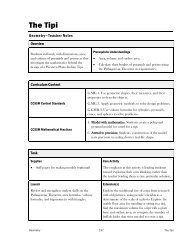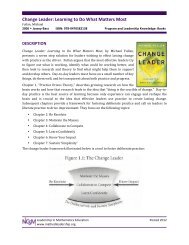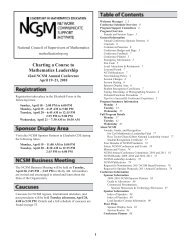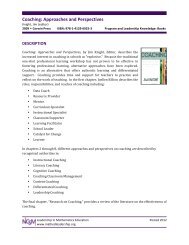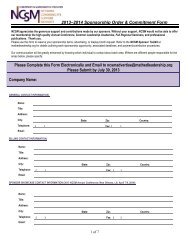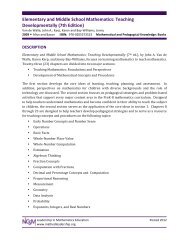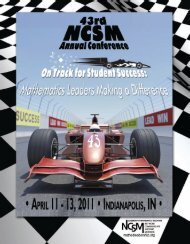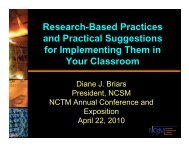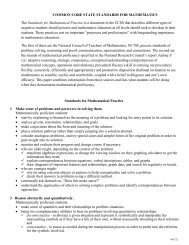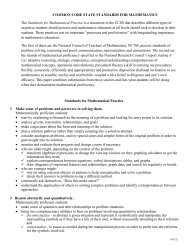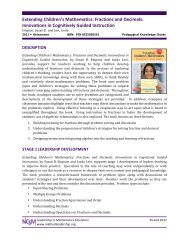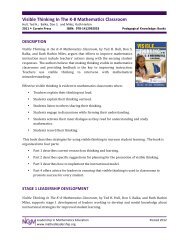Teaching Fractions and Ratios for Understanding: Essential Content ...
Teaching Fractions and Ratios for Understanding: Essential Content ...
Teaching Fractions and Ratios for Understanding: Essential Content ...
Create successful ePaper yourself
Turn your PDF publications into a flip-book with our unique Google optimized e-Paper software.
<strong>Teaching</strong> <strong>Fractions</strong> <strong>and</strong> <strong>Ratios</strong> <strong>for</strong> Underst<strong>and</strong>ing: <strong>Essential</strong> <strong>Content</strong> Knowledge <strong>and</strong> Instructional Strategies <strong>for</strong> Teachers Lamon, Susan J. 2005 w Lawrence Erlbaum ISBN: 978-‐0805852103 Mathematical <strong>and</strong> Pedagogical Knowledge: Books DESCRIPTION <strong>Teaching</strong> <strong>Fractions</strong> <strong>and</strong> <strong>Ratios</strong> <strong>for</strong> Underst<strong>and</strong>ing: <strong>Essential</strong> <strong>Content</strong> Knowledge <strong>and</strong> Instructional Strategies <strong>for</strong> Teachers, 2nd edition, by Susan J. Lamon, pushes readers to teach <strong>for</strong> underst<strong>and</strong>ing <strong>and</strong> to develop their own underst<strong>and</strong>ing of mathematical concepts. It asks readers to move beyond the limits of their current underst<strong>and</strong>ing of rational numbers, challenging them to refine <strong>and</strong> explain their thinking, without falling back to rules <strong>and</strong> procedures on which they may have previously relied. The book argues that the detrimental consequences of teaching students to merely “do” mathematics rather than to underst<strong>and</strong> concepts becomes critical <strong>for</strong> students in gaining access to higher level mathematics <strong>and</strong> science. Promising new activities <strong>and</strong> teaching methods that are outcomes of research are provided <strong>and</strong> give direction <strong>for</strong> changing instruction. An underlying assumption is that facilitating teacher underst<strong>and</strong>ing using the same questions <strong>and</strong> activities that may be used with children is one way to help teachers build the com<strong>for</strong>t <strong>and</strong> confidence they need to begin teaching <strong>for</strong> underst<strong>and</strong>ing. The goal of this book is to provide teaching methods <strong>and</strong> materials that may be used with teachers <strong>and</strong> also with students to promote the ideas <strong>and</strong> ways of thinking that lead to the development of proportional reasoning. STAGE 1 LEADERSHIP DEVELOPMENT <strong>Teaching</strong> <strong>Fractions</strong> <strong>and</strong> <strong>Ratios</strong> <strong>for</strong> Underst<strong>and</strong>ing: <strong>Essential</strong> <strong>Content</strong> Knowledge <strong>and</strong> Instructional Strategies <strong>for</strong> Teachers, 2nd edition, by Susan J. Lamon, supports stage 1 development of specialists in the role of coaching working to increase their knowledge of fractions <strong>and</strong> ratios. For a specialist working to meet the <strong>Teaching</strong> <strong>and</strong> Learning principle, this book provides examples of activities <strong>and</strong> teaching methods useful in developing <strong>and</strong> modeling knowledge about improving student learning. For students needing additional support with fractions <strong>and</strong> ratios, this book will be a useful resource. Chapter 1 gives an overview of proportional reasoning including a discussion of the components of underst<strong>and</strong>ing that are essential to powerful reasoning. Reasons <strong>for</strong> changing instruction are provided <strong>and</strong> include: 1. Fraction, ratio, <strong>and</strong> rational number ideas are complex <strong>and</strong> interconnected. 2. Many students have a limited underst<strong>and</strong>ing of the various meanings of fraction representations. 3. Instruction needs to actively facilitate thinking leading to proportional reasoning. 4. Long-‐term studies show that instruction can be improved. Leadership in Mathematics Education www.mathedleadership.org Posted 2012
Chapters 2 through 15 address specific topics related to fractions <strong>and</strong> ratios <strong>and</strong> include children’s strategies, activities to try, <strong>and</strong> reflection questions that are useful <strong>for</strong> personal reflection <strong>and</strong> as starting conversations with colleagues about the development of proportional reasoning. For those interested in further resources, a supplement called More: In-‐Depth Discussion of the Reasoning Activities in “<strong>Teaching</strong> <strong>Fractions</strong> <strong>and</strong> <strong>Ratios</strong> <strong>for</strong> Underst<strong>and</strong>ing” is available. More than an answer key, it provides additional discussion of the issues along with teaching problems that may be useful <strong>for</strong> assessment purposes. STAGE 2 LEADERSHIP DEVELOPMENT <strong>Teaching</strong> <strong>Fractions</strong> <strong>and</strong> <strong>Ratios</strong> <strong>for</strong> Underst<strong>and</strong>ing: <strong>Essential</strong> <strong>Content</strong> Knowledge <strong>and</strong> Instructional Strategies <strong>for</strong> Teachers, 2nd edition, by Susan J. Lamon, supports stage 2 development of leaders working to implement research-‐in<strong>for</strong>med best practices. Unlike a textbook that provides <strong>for</strong>mal theory, this book uses problems <strong>and</strong> activities that will become valuable resources <strong>for</strong> use in elementary <strong>and</strong> middle school classrooms. Facilitating a group of thoughtful practitioners working through the problems <strong>and</strong> reflecting on the discussions in the book will help them to deepen their own underst<strong>and</strong>ing of fractions <strong>and</strong> ratios. The methods <strong>and</strong> activities have been tested with students from grades 3 through 8 <strong>and</strong> provide ideas <strong>for</strong> use in participants’ classrooms. Some of the ways the book has been used include: • Mathematics or mathematics methods courses <strong>for</strong> pre-‐service elementary teachers: This book provides enough material <strong>for</strong> a three-‐credit, fifteen-‐week course. • Integrated mathematics <strong>and</strong> mathematics methods course: Participants might study a chapter a week, work <strong>and</strong> discuss all of the problems, <strong>and</strong> then videotape <strong>and</strong> analyze interviews with students solving the same problems. • In-‐service courses: Several chapters might be introduced in a two-‐week summer seminar <strong>and</strong> then throughout the year chapters might be discussed during in-‐service days. Regardless of how the facilitator uses the book, it is important to provide time <strong>for</strong> personal problem solving <strong>and</strong> reflection <strong>and</strong> then time to work with others. Abundant discussion of the activities <strong>and</strong> sharing of explanations, strategies, <strong>and</strong> solutions are critical to the success of the activity. Leadership in Mathematics Education www.mathedleadership.org Posted 2012



